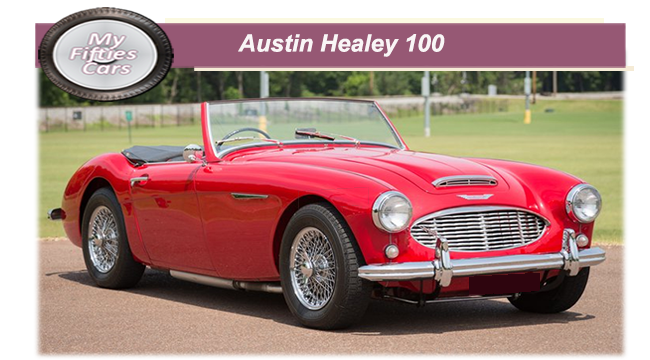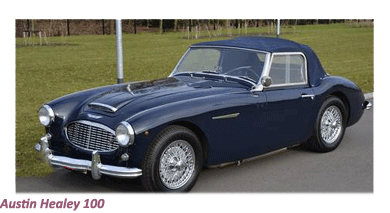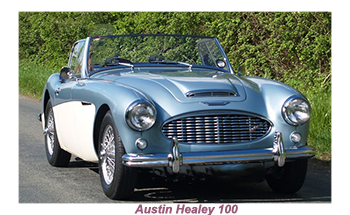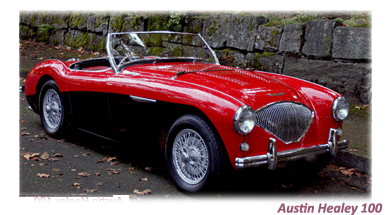
Interestingly the Austin Healey 100, one of the most iconic sports cars of the Fifties was born from the ashes of one of the decade’s least successful, the quirky Austin A90 Atlantic.
 The Donald Healey Motor Company had been in business since 1946, producing low-volume sports tourers and sports cars, with the best-known models being the Westland and the Silverstone. However, Donald Healey, the owner and founder, not only knew a lot about producing fine cars but was also an astute businessman.
The Donald Healey Motor Company had been in business since 1946, producing low-volume sports tourers and sports cars, with the best-known models being the Westland and the Silverstone. However, Donald Healey, the owner and founder, not only knew a lot about producing fine cars but was also an astute businessman.
 During the early Fifties, Healy spotted a gap in the market for a more affordable two-seater, which could compete against MG and Jaguar, and set about designing a prototype, known as the Healey Hundred, in 1952.
During the early Fifties, Healy spotted a gap in the market for a more affordable two-seater, which could compete against MG and Jaguar, and set about designing a prototype, known as the Healey Hundred, in 1952.
Donald Healey, who had already established a strong working relationship with Austin, took an A90 engine and chassis to form the basis of a prototype Healey 100, which the company unveiled at the Earls Court Motor Show of 1952.
According to legend has it that the prototype appeared on preview day as the Healey Hundred but an overnight meeting between Donald Healey and Leonard Lord, CEO of Austin Motors.
 This chance meeting resulted in a deal that saw the car rebadged for the first public day of the show as the Austin-Healey 100, although there remain conflicting reports that Lord and Healey had already discussed the possibility of a working relationship between the two companies.
This chance meeting resulted in a deal that saw the car rebadged for the first public day of the show as the Austin-Healey 100, although there remain conflicting reports that Lord and Healey had already discussed the possibility of a working relationship between the two companies.
![]()
What is now history is that BMC were so impressed with Healey's streamlined roadster that they decided to sponsor a production run.
 The Austin Healey 100 structure was advanced for the period, with the inner steel panels of the shell welded to a sturdy box-section (with cruciform) chassis frame on manufacture, effectively making this a monocoque.
The Austin Healey 100 structure was advanced for the period, with the inner steel panels of the shell welded to a sturdy box-section (with cruciform) chassis frame on manufacture, effectively making this a monocoque.
 The BN1 model that resulted had its body/chassis unit completed, painted and trimmed produced for the newly formed Austin-Healey partnership by Jensen Motors at their West Bromwich plant and finished at BMC's Longbridge plant in Birmingham.
The BN1 model that resulted had its body/chassis unit completed, painted and trimmed produced for the newly formed Austin-Healey partnership by Jensen Motors at their West Bromwich plant and finished at BMC's Longbridge plant in Birmingham.
 Except for the earliest models (which used many aluminium skin panels), steel, the unladen weight of the 100 increasing by about 1351b between 1953 and 1956.
Except for the earliest models (which used many aluminium skin panels), steel, the unladen weight of the 100 increasing by about 1351b between 1953 and 1956.
The BN1 was powered by a well-tuned A90 engine and drivetrain with modified manual transmission — a three-speed box with overdrive on second and top gears, independent front suspension and Girling drum brakes were fitted all round.
![]()
These classics with their fold-flat windscreens and clean-cut lines with few embellishments hit the market in the summer of 1953 and were well received by the public, vindicating BMC's decision to back Donald Healey's vision.
E ven better for BMC, the Austin-Healey 100 went on to become a top seller in the United States, establishing the company as a force to be reckoned with in the international sports car market.
ven better for BMC, the Austin-Healey 100 went on to become a top seller in the United States, establishing the company as a force to be reckoned with in the international sports car market.
A Mark II version of the Austin- Healey 100, known internally as the BN 2 appeared in 1955, offering a four-speed gearbox, new rear axle and a choice of natty paint jobs, as well as a two-tone option.
 To satisfy those sporty buyers who craved extra performance, a modified 100M version was created, distinguishable by its louvred bonnet (complete with strap).
To satisfy those sporty buyers who craved extra performance, a modified 100M version was created, distinguishable by its louvred bonnet (complete with strap).
>In 1956 Austin-Healy released the larger and more powerful Austin-Healey 3000, signalling the end of the BN2, with the final model released in July of 1956.
A total of 4604 BN2s were produced, including the 100M variation.
Take me back to the home page.


